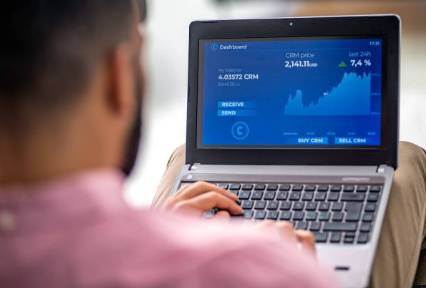Welcome to the world of Bitcoin – the digital currency that has taken the financial landscape by storm. Whether you’re a tech-savvy investor or just someone curious about this mysterious phenomenon, understanding the basics of Bitcoin is essential in today’s fast-paced digital age. In this blog post, we will unravel the mysteries surrounding Bitcoin and delve into its inner workings, demystifying complex jargon along the way. So buckle up and get ready to dive into an exciting journey where traditional monetary systems meet cutting-edge technology!
Introduction to Bitcoin

Bitcoin is a digital currency or cryptocurrency that was created in 2009 by an unknown person using the alias Satoshi Nakamoto. It operates independently of any central authority or government, making it a decentralized form of currency. This means that no single entity controls its production, distribution, or use.
At its core, Bitcoin is based on blockchain technology, which is essentially a publicly distributed ledger that records all transactions made with the currency. This allows for transparency and security as every transaction can be traced and verified.
How does it work?
Bitcoin works through a peer-to-peer network where users can send and receive payments without the need for intermediaries such as banks. Instead, all transactions are recorded on the blockchain and validated by a network of computers called nodes.
These nodes are responsible for verifying the authenticity of each transaction by solving complex mathematical puzzles. Once a transaction is verified, it is added to a block and then linked to previous blocks in the blockchain, creating an unchangeable record of all transactions.
Acquiring Bitcoin
There are several ways to acquire Bitcoin. The most common way is through buying them on cryptocurrency exchanges using traditional fiat currencies like USD or EUR. You can also earn Bitcoins by selling goods or services and requesting payment in this digital currency.
Another method is mining, which involves using specialized computer hardware to solve complex mathematical problems and earn Bitcoins as rewards. However, this method requires significant computing power and electricity costs, making it less accessible for average users.
History of Bitcoin

The history of Bitcoin dates back to 2008, when a mysterious individual or group known as Satoshi Nakamoto published a whitepaper titled “Bitcoin: A Peer-to-Peer Electronic Cash System”. This paper outlined the concept of a decentralized digital currency that could be transferred between individuals without the need for intermediaries such as banks.
However, it wasn’t until January 3rd, 2009 that the first Bitcoin was created and the network officially went live. This day is now known as “Bitcoin’s birthday” and marks the beginning of its journey towards becoming one of the most talked-about assets in the world.
In its early days, Bitcoin was primarily used by a small community of tech enthusiasts and cryptography experts. It gained some attention due to its potential to disrupt traditional financial systems, but it wasn’t until 2010 that it started gaining mainstream recognition. That year, Laszlo Hanyecz famously made history by purchasing two Papa John’s pizzas for 10,000 Bitcoins – an amount worth millions of dollars today.
As more people started paying attention to this new form of digital currency, its value began to rise exponentially. In February 2011, one Bitcoin was valued at around $1 USD. By December of that same year, it had reached an all-time high of $31 USD per coin.
Despite this initial success, there were still many skeptics who doubted whether Bitcoin would ever become widely adopted or have any real-world use cases beyond speculation. However, in
How Does Bitcoin Work?
Bitcoin is a decentralized digital currency that was created in 2009 by an unknown individual or group under the pseudonym “Satoshi Nakamoto”. Unlike traditional currencies, Bitcoin is not controlled by any central authority such as a government or bank. Instead, it operates on a peer-to-peer network known as the blockchain.
The blockchain is essentially a public ledger of all Bitcoin transactions that have ever been made. This means that every transaction can be traced and verified by anyone with access to the blockchain. This transparent system allows for secure and efficient transfers of value without the need for intermediaries like banks.
So how does Bitcoin actually work? Let’s break it down into three main components: mining, transactions, and wallets.
Transactions:
Once new bitcoins are generated through mining, they can then be transferred from one user to another in what are known as transactions. These transactions are recorded on the blockchain and can be viewed by anyone with access to it. Each transaction includes information about the sender, recipient, amount sent, and transaction fees.
When making a transaction with Bitcoin, users must use their private key (a unique code assigned to each bitcoin wallet) to digitally sign it. This ensures that only
The Blockchain Technology behind Bitcoin

The Blockchain technology is the backbone of Bitcoin, and it is what makes this digital currency unique and revolutionary. To understand how Bitcoin works, it is crucial to have a clear understanding of the Blockchain technology.
What is Blockchain?
Blockchain can be described as a decentralized ledger that records all transactions made on the network in a tamper-proof manner. It operates on a peer-to-peer network of computers, where every computer or node has a copy of the entire blockchain. This means that there is no central authority controlling the network, making it secure and transparent.
How does Blockchain work?
When someone initiates a transaction using Bitcoin, it gets broadcasted to all nodes on the network. These nodes then verify whether the transaction is valid by checking if the sender has sufficient funds and if they are not trying to double-spend (spend the same bitcoins more than once). Once verified, this transaction gets added to a block along with other valid transactions.
Before being added to the blockchain, each block must go through a process called “mining.” Mining involves solving complex mathematical problems using specialized computers known as miners. The first miner to solve these problems validates and adds that particular block to the blockchain. Additionally, they are rewarded with newly created Bitcoins for their effort.
Once added to the blockchain, each block’s information becomes permanent and cannot be altered or deleted. This makes it impossible for anyone to manipulate past transactions without getting detected by others on the network.
Why is Blockchain important for Bitcoin?
The decentralized nature of blockchain
Benefits of Using Bitcoin
Bitcoin has been gaining popularity as a form of digital currency and many are intrigued by its features and potential. While it may seem complex at first, understanding the basics of Bitcoin can open up a world of benefits for users. In this section, we will explore the advantages of using Bitcoin and how it differs from traditional forms of currency.
1. Decentralization: One of the main benefits of using Bitcoin is its decentralized nature. Unlike traditional currencies that are controlled by central banks and governments, Bitcoin operates on a peer-to-peer network where transactions are verified by nodes all over the world. This means that no single entity has control over the currency, making it less susceptible to government interference or manipulation.
2. Anonymity: Another advantage of using Bitcoin is the anonymity it offers to users. Transactions on the blockchain are pseudonymous, meaning that they are not directly linked to an individual’s identity. This provides a level of privacy that cannot be achieved with traditional financial systems, where personal information is often required for transactions.
3. Lower transaction fees: Traditional banking systems often charge high transaction fees for cross-border payments or international transfers. With Bitcoin, these fees are significantly lower as there is no need for intermediaries such as banks or payment processors. This makes it an attractive option for businesses and individuals looking to save on transaction costs.
4. Fast and efficient: Compared to traditional banking systems which can take days or even weeks to process transactions, Bitcoin offers near-instantaneous transfers that can be completed within minutes
Risks and Challenges of Bitcoin
Bitcoin, the world’s first decentralized digital currency, has gained widespread attention and adoption since its inception in 2009. While it offers several benefits such as lower transaction fees and faster cross-border payments, there are also risks and challenges associated with using Bitcoin. In this section, we will discuss some of the potential risks and challenges that users may face when dealing with Bitcoin.
1. Volatility: One of the biggest concerns surrounding Bitcoin is its highly volatile nature. The value of Bitcoin can fluctuate significantly in a short period of time due to various factors such as supply and demand, government regulations, media coverage, and investor sentiment. This volatility makes it challenging for users to determine the true value of their investments or conduct everyday transactions without being affected by price changes.
2. Security Risks: As with any digital platform, there are inherent security risks associated with using Bitcoin. These risks include hacking attempts on exchanges or wallets where Bitcoins are stored, phishing scams targeting users’ private keys or login credentials, and malware attacks on devices used to access Bitcoins. Since transactions on the blockchain cannot be reversed or canceled once confirmed, any loss or theft of Bitcoins due to security breaches can result in permanent financial loss for users.
3. Lack of Regulation: The decentralized nature of Bitcoin means that it is not controlled by any central authority or government entity. While this gives users more freedom and privacy in their transactions, it also means that there is no regulatory body overseeing the use of Bitcoins.

